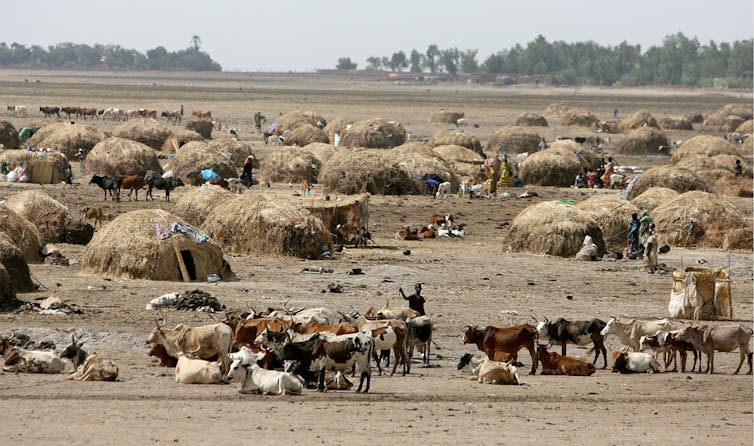
As fireworks were lighting up the skies to usher in the New Year across the world, gunfire was echoing out in Nigeria’s Benue State. On this night alone, 73 people were killed and hundreds were injured after herdsmen unleashed terror in two local government areas mostly populated by farmers.
Clashes between farmers and nomadic herdsmen date back to the pre-colonial era. But they reached an alarming level in 2017 when 1,000 people were killed in more than 50 clashes. This followed a rise in clashes since 2011 in Nigeria, Ghana, Mali, Niger, Mauritania, Ivory Coast and Senegal.
The dramatic rise in the number, frequency and intensity of attacks in recent years is increasingly been seen as a major source of concern in the region. A 2017 Global Terrorism Index report said that over 2 500 deaths were recorded between 2012 and 2016 in sub-Saharan Africa with majority of the deaths recorded in Nigeria. And while there were 67 clashes between farmers and herdsmen in Nigeria between 2007 and 2011, there were 716 clashes between 2012 and 2018.
Access to land and water, grazing paths, drought, desertification and ethnicity all contribute to the violence. Attacks often happen when cattle stray into farmland and destroy farm products. But the sudden increase in the number of attacks and casualties suggests that the conflict goes beyond access to natural resources and climate change.
There’s growing evidence that conflicts in the region are contributing to the dramatic rise in the number of attacks as well as casualties. For example, violence is being fuelled by the unrest in Libya – which has been on going since 2011 – as well as the six-year long conflict in Mali. These regional conflicts have resulted in proliferation of weapons – for example herdsmen are often armed with weapons, including some sourced from Libya, as well as new trends in cattle rustling and animal trafficking in the entire region.
Arms proliferation
The 2011 conflict in Libya has led to unprecedented levels of arms proliferations in the Sahel Sahara as well as sub-Saharan Africa and contributed to the conflict in Mali. Terrorist organisations such as AQIM and Boko Haram have also benefited from the arms bazaar, with the region flooded with thousands of light weapons.
The growing illegal weapons market in the region has coincided with a tremendous increase in cattle rustling in the region since 2011. This is being driven by what has come to called neo-pastoralism, a trend that involves cartels using illegally acquired wealth to arm young men to steal cattle from nomads. The cattle are then moved to large ranches or across several national boundaries for sale. The cartels have been driven by rising prices for beef, with an adult cow selling for $1,000 in the region.
Neo-pastoralism has led to an increase in the numbers of herdsmen bearing arms. These same weapons are used against farmers at the slightest provocation as anyone seen to hinder their nomadic activities is regarded an enemy.
While the clashes between farmers and herdsmen have sometimes been branded as ethnic or religious in nature, the economic perspective is also a source of concern. There have been reports of an unmarked helicopter dropping supplies for herdsmen in far-flung areas. Community leaders in Taraba State recently made a similar claim: that helicopters were seen dropping weapons for herdsmen.
Herdsmen argue that they now carry weapons to protect themselves and their cattle due to the increased threats they face. For their part, farmers have started forming armed vigilante groups to protect themselves from attacks by herdsmen. The result has been a rising cycle of violence.
On top of this, disputes and clashes that would previously have been resolved through dialogue between the local community leaders and the herdsmen now play out in all out warfare.
Too slow and ineffective
The response from governments in the region has been mixed. Nigeria has been criticised for its lackadaisical approach. In an effort to prove that it’s serious about ending the clashes, the air force recently launched attacks on several villages killing innocent people. This response was roundly criticised Amnesty International for being:
totally inadequate, too slow and ineffective, and in some cases unlawful.
For its part, the Ghanaian government sees the herdsmen as the aggressors. Police officers have orders to shoot encroaching cattle on sight, adding a new twist to the conflict.
Niger, meanwhile, has taken a different approach, using Islamic teaching to warn people about the consequences of cattle rustling and murder. This has led to herdsmen surrendering of 30 guns to the police.
A regional multi-national approach?
The menace is fast spiralling out of control and requires an urgent regional response. The porous nature of the borders coupled with large ungoverned spaces show that this is a regional problem that must be addressed collectively, mirroring the response to the Boko Haram insurgency.
Some governors in Nigeria including the governor of Benue state believe ‘ranching’– rearing cattle in ranches rather than moving them around the country for graving is the only solution to the crises. Although ranching is a good idea, it might not resolve the problem as it negates the culture and tradition of nomads. Instead, grazing routes that are acceptable to both farmers and herdsmen should be marked out as a matter of urgency.
![]() In addition, a multi-national initiative to curb arms trafficking should be top of the agenda in addressing this incessant loss of lives and property.
In addition, a multi-national initiative to curb arms trafficking should be top of the agenda in addressing this incessant loss of lives and property.
Olayinka Ajala, Associate Lecturer and Conflict Analyst, University of York. This article was originally published on The Conversation.

